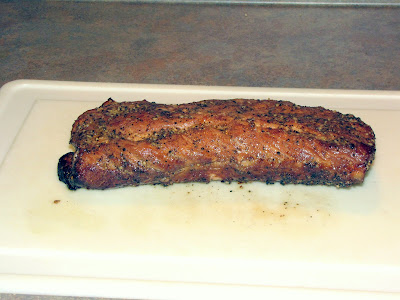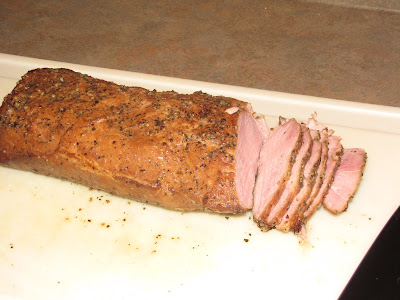
I've made Canadian bacon a couple of times and it has really turned out well. It tastes good with a lot of things, but my son's favorite is homemade "Egg McMuffins"; a muffin, egg, a good cheese and a slice or two of this Canadian bacon. Use a pork loin, not a pork tenderloin. Mine was 5-6 lbs. In a nutshell the loin is cured in the refrigerator for 5 or 6 days, then it is smoked for a few hours.
My brine is usually something like the following. It varies a little, depending on what I feel like adding to it at the time.
Water to cover the meat, usually about a gallon, depending on the container you are curing it in.
For every gallon of water use:
- 2 Tablespoon of Instacure #1 (Prague Powder) for every half gallon of water. Some recipes call for more Instacure, I tend to go lighter on it. - OR use the appropriate amount of Morton's Tender Quick. I don't know the conversion factor, since Tender Quick has the salt and the curing salt combined.
- 4 Tablespoons of canning salt.
- 5 to 10 (depending on your taste, I use 10) smashed garlic cloves. Take a wide-bladed knife turned sideways or something similar and smash the garlic on your counter, but not so hard that it flies into pieces. This releases the garlic oils and taste.
- About a Tablespoon or so of onion flakes.
- 1/4 cup or so of sugar, preferably brown sugar.
Some optionals; be creative, there are a lot more options than these:
- 2 or 3 FRESH bay leaves. If you don't have a bay tree growing in a container, get one! Once you've had fresh bay you will never go back.
- a teaspoon of fresh-cracked pepper.
- a Tablespoon, or more, or less, depending on you, of a hot-pepper powder. If I add pepper I use dried jalapeno powder because I dry my own jalapenos.
Put the meat into a bowl/pot large enough to hold it, covered with the brine. It looks awful in this picture but that is because the water has spices and such in it. The piece of meat in the middle is the pork loin, the other smaller pieces were something else I was working on at the same time:

Place something on top of the meat to hold it under the surface of the brine. I usually use a small plate with a mug full of water to weigh it down. Keep it in the refrigerator for 5 or 6 days.
When the loin is done curing, pour out the liquid and replace with clean water. Let the meat soak in the water for about an hour, and change the water 2-3 times. This will remove some of the saltiness. You can get creative with your rub at this point, but I covered this one only in fresh-cracked pepper. I ran out of pepper, and usually cover the meat a lot more than this:

Next I place it on my smoker.

I have a small smoker and it is hard to regulate a good cooking temperature, so first I smoke it at a low to medium smoker heat for about 3 hours. I like to get it to a safe heat of 160 degrees, and I don't want to dry it out, so I finish it up in the kitchen oven. I wrap the loin in heavy duty aluminum foil and pour in a small amount of water.
At 350 degrees I think it took an hour or two to get it to an internal temperature of 160 degrees, checked with a meat thermometer.
After the loin has reached 160 degrees, I remove it and let it rest for about 30 minutes.

Next simply slice it up. I usually slice it about 1/8th to 1/4th of an inch, but the thickness is up to you.

I usually store half of it vacuum-packed in the freezer, it seems to stand up to freezing well. However, there is nothing like a fresh piece!

